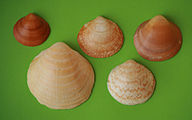Glycymeris
| Glycymeris Temporal range:
| |
|---|---|

| |
| Fossil shells of a Glycymeris species from the Upper Pliocene | |
| Scientific classification | |
| Kingdom: | Animalia |
| Phylum: | Mollusca |
| Class: | Bivalvia |
| Order: | Arcida |
| Family: | Glycymerididae |
| Genus: | Glycymeris da Costa, 1778 |
Glycymeris, common name the bittersweet clams, is a genus of saltwater clams, marine bivalve molluscs in the family Glycymerididae.
Etymology[]
The genus name comes from the Ancient Greek word glykymaris (perhaps from Glykys (sweet) and Meris (part)), a word which is only recorded once in Greek literature.
Fossil records[]
These clams are very common as fossils, from the Cretaceous period in the Valanginian age (between 140.2 ± 3.0 mya and 136.4 ± 2.0 mya). Fossil shells of these molluscs can be found all over the world. Genus Glycymeris includes about 100 extinct species.[1][2]

Description[]
The shells are generally biconvex, with equal valves round in outline, and slightly longer than wide. Their size varies from medium to large. The external ligament lacks transverse striations. These clams are a facultatively mobile infaunal suspension feeders.
Habitat[]
They are widespread on shallow seabeds that consist of heterogeneous-grained sediments.
Species[]
Species within this genus include:[3]
- (Lischke, 1872) - White-lined bittersweet
- Glycymeris americana (DeFrance, 1829) - Giant bittersweet
- Glycymeris aspersa (Adams & Reeve, 1850)
- Glycymeris bimaculata (Poli, 1795) - Two-spotted bittersweet
- Lamarck
- Tomlin, 1925
- Glycymeris decussata (Linnaeus, 1758) - Decussate bittersweet
- (Reeve, 1843)
- Glycymeris glycymeris (Linnaeus, 1758) - Dog cockle or European bittersweet
- (Nowell-Usticke, 1959)
- Glycymeris longior (Broderip & G. B. Sowerby I, 1833)
- Glycymeris modesta (Angas, 1879)
- Melvill, 1897 - Muscat bittersweet
- Glycymeris nummaria (Linnaeus, 1758)
- (Reeve, 1843)
- Glycymeris pectinata (Gmelin, 1791) - Comb bittersweet
- (Lamarck, 1819)
- (Linnaeus, 1758)
- (Mayer, 1868) - Reeve's bittersweet
- (Lamarck, 1819) - Rayed bittersweet
- (Dunker, 1882)
- (Middendorff, 1849)
- (Reeve, 1843)
- Glycymeris spectralis Nicol, 1952 - Spectral bittersweet
- Sowerby, 1833
- (Reeve, 1843)
- Glycymeris undata (Linnaeus, 1758) - Atlantic bittersweet
- Glycymeris yessoensis (Sowerby, 1886)
Gallery[]
Fossil Glycymeris glycymeris at the Geopaleontologic Museum GAMPS

Glycymeris glycymeris - Meermandel

Glycymeris glycymeris - Galicia (Spain
Glycymeris modesta - Pakiri, New Zealand
See also[]
References[]
- ^ Paleobiology database
- ^ Sepkoski, Jack Sepkoski's Online Genus Database
- ^ Biolib
- Glycymeris
- Bivalve genera
- Extant Cretaceous first appearances
- Taxa named by Emanuel Mendez da Costa
- Bivalve stubs



